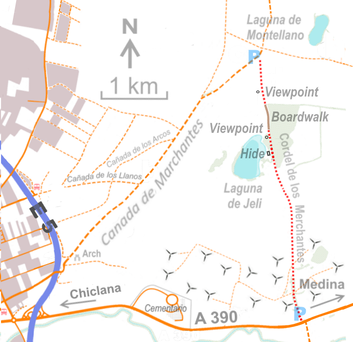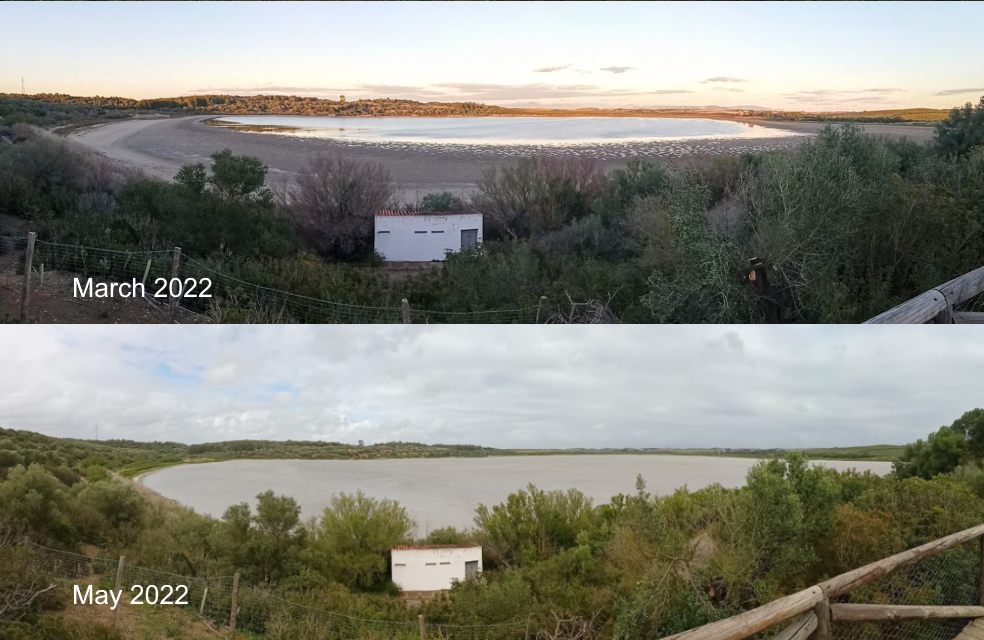For most birders visiting Cadiz province, "lagunas" means checking Laguna de Medina to see White-headed Duck and, with luck, Red-knobbed Coot plus the hope of seeing Ferruginous or Marbled Duck or, more recently, Olivaceous Warbler. To be fair, as its sited just off the fast A 381 near Jerez (into which many will fly), is relatively easy to scan and rarely dries out (unlike other lagunas) this makes a lot of sense. In March this year, after a long dry winter, I thought 2022 would be one of those rare 'dry' years when the 'laguna' becomes a shallow depression of sun-baked mud. The water level was even lower than I've seen it in August when one might expect the water level to be very low following the driest months of summer. However, by May, thanks to some heavy rain in late March/April, it was pretty much full. Visits in late April this year produced 700+ Flamingo, a single Red-knobbed Coot, 2 Marbled Duck, 2 White-headed Duck, 112 Red-crested Pochard (a good count according to e-Bird) and a good assortment of waders including 50+ Ringed Plover, 5+ Little Ringed Plover, 2 Lapwing, 3 Black-tailed Godwit, 2 Ruff, and a 70+ small waders (mostly to far away to identify with absolute confidence but those that were nearby below the hide consisted of 9 Curlew Sandpiper, 3 Dunlin and 2 Little Stint). Luckier observers had a Pectoral Sandpiper drop in. Unfortunately, most small waders here tuck themselves into the corner of the laguna 500-600m from (and at a difficult angle to) the hide so only birds that drop onto the thin strip of mud in front of the hide can be easily identified. It's a pity there's not a second better placed hide to view this corner. It was disappointing to find only a couple of White-headed Ducks confirming that 'Bonanza Pools' are by far the best place to look for this target species. Perhaps the recent drought conditions are responsible for this poor showing although the occasional drought helps in the long term by excluding colonisation by carp.
It was also interesting to take a closer look at the series of small lagunas in a small quarry just north of the reserve. These have presumably been developed as some sort of "mitigation" by the nearby cement factory. They can be viewed from the service road but hopefully some sort of formal access may be arranged and a path (circled in red in the GoogleEarth image below) looks like it's meant to connect with the main reserve. They held no more than large numbers of Yellow-legged Gull, a few Red-crested Pochard and Little Ringed Plover but may be worth keeping an eye on. .
In addition to their relative obscurity and poor access, some of the other lagunas in the area suffer from what, frankly, seems to be neglect. Some, for example, like the Lagunas de Espera have ill-sited hides now entirely (or almost entirely) obscured by vegetation but most have no provision for the public to see and enjoy the birdlife at all. One example of both problems are the three lagunas that make up the Lagunas de Puerto Real. Laguna de Comisario is the largest and potentially the best but, although I didn't stop there this May, checking on GoogleEarth it still seems inaccessible (or legitimately so). Laguna de San Antonio has always been completely overgrown but when I first looked at Laguna de Taraje I called it a 'hidden gem'. You could still get a decent view across much of the laguna from the track and there was a reasonably large stretch of open water that attracted wildfowl. However, when I looked at the site this May I found it almost entirely choked with vegetation with only a small area of open water suggesting its heading the same way as the Laguna de San Antonio. Admittedly, such a long dry winter it's probably drier than usual but without restorative work the laguna will surely join others in the area and disappear. With the track to the laguna now in a very poor condition, the only reason to visit the site is to slake your curiosity.

Yet my growing pessimism ebbed considerably after a visit to the Laguna de Jeli. This is another site too long ignored by birders because it's less well-known than Laguna de Medina and less convenient to visit (although a good deal easier than most imagine). Over a decade ago when I first tried to visit the laguna I couldn't find the path from the A 390 (Chiclana - Medina Sidonia road) by which it was supposed to be accessed. This was a forgivable oversight as the path was then narrow, badly overgrown and un-signposted with nowhere to pull-off on the main road. How things change! As one of the slides below shows, the footpath (Cordel de los Merchantes) is now very well-signposted on the A 390 (although you have to stop to find out where it goes) with a convenient car park.


 RSS Feed
RSS Feed
